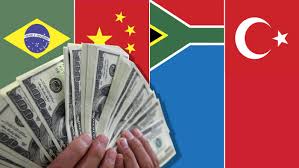How emerging-market local-currency bonds might fit in your portfolio

IN THE FIRST episode of “Cheers”, a 1980s television comedy, Diane Chambers, a graduate student, intends to elope with Sumner Sloan, a literature professor. In stark contrast to the genial barflies at Cheers, a Boston watering-hole, Sloan is well-educated and middle-class—but also, it turns out, vain and deceitful. He’s goofy, says Sam Malone, the bartender whose on-off romance with Diane is the show’s dramatic axis. “He’s everything you’re not,” she retorts.
And so is Diane. That she and Sam are dissimilar in personality and social background is one reason why “Cheers” is so funny. The yoking of opposites is a dependable ploy in situation comedies. It is also a useful trick in investing. The injunction not to put all your eggs in one basket can be found in any finance textbook. But there is more to diversification than that. The ideal diversifier is not just something other than what you own, but something that contrasts with it.
Suppose your investments are tilted heavily towards the S&P 500 index of America’s leading shares, a principal character in global capital markets. Where can you find a Diane Chambers to balance your Sam Malone? Emerging-market government bonds in the issuer’s own currency may be the contrast you are seeking. They are not stocks, they are not denominated in dollars and they are not widely owned by foreigners. They are everything your existing portfolio is not.
Investing in emerging markets opens up a broader set of opportunities. GDP growth is generally faster, as there is greater scope to benefit from existing know-how than in rich economies. The business cycle is different, too. There is a spectrum of risk assets to choose from. The cautious prefer hard-currency bonds, which pay in dollars and are issued by governments and firms.
Further along the spectrum are racier bets. Shares carry the same hazards in emerging markets as anywhere else. Stockholders are behind bondholders in the queue to be paid, should earnings falter. But there is an additional exchange-rate risk: a fall in local currencies would be a money-loser for rich-world investors.
For those willing to take on foreign-exchange risk, government bonds issued in local currency might have more appeal. Government bonds are in general a hedge against equity risk. And while indices of emerging-market stocks lean heavily towards Asia, and thus to China’s supply-chain, bond indices have broader regional balance, says Yacov Arnopolin of PIMCO, a big bond firm. Expected returns are decent. For instance, the yield on the J.P. Morgan GBI-EM index of biggish issuers is 6.2% (see chart). That is considerably higher than the yield on Treasury bonds.
This yield spread is a buffer against currency risk. A bet on local-currency bonds is in essence a bet against the dollar. Ideally you would gain on both the bonds and the currency. But at the very least, you hope the “carry” (extra yield) will make up for any exchange-rate losses. An important consideration is whether the currencies you are buying into are overvalued. It is not obvious that they are. Real exchange rates in most big emerging markets are either close to their ten-year averages or below them.
A burst of inflation would alter the calculation. Currencies would then need to fall to keep the real exchange rate steady and exports competitive. Yet there has been a notable drop in inflation in emerging markets. Partly this is down to the adoption of inflation targets by central banks; partly it is more disciplined fiscal policy, says Jan Dehn of Ashmore, a fund manager. Of the 25 emerging markets listed on the indicators page of The Economist, only three (Argentina, Egypt and Turkey) have inflation in double digits. For most, it is below 3%.
Of course, the fate of the dollar is also a key consideration. Shifts in risk appetite will make the dollar jumpy. It tends go up against most currencies when traders fret about the world economy. But the Federal Reserve has indicated that it is not inclined to raise interest rates in America for a while. That militates against further dollar strength.
To buy local-currency bonds is to bet on a falling dollar. That might seem reckless. In fact, such bonds are a counterweight to the typical equity portfolio, which is groaning with American stocks and thus heavily exposed to dollar risk. They tend to have a low weight in rich-world bond portfolios, says Mr Dehn. Local-currency bonds sit as awkwardly among “safe” Treasuries or Bunds as Sumner Sloan in a blue-collar Boston bar. In short, they are quite unlike everything you already own.

